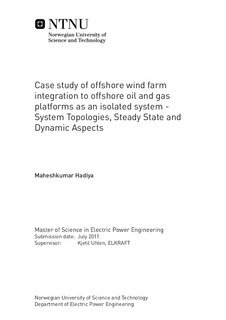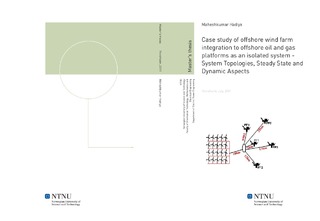| dc.description.abstract | The objective of this thesis work has been to investigate the electric system stability, reliability and power security of an off-grid isolated network system integration of an offshore wind farm to offshore oil and gas platforms via HVAC transmission, considering different network topologies for wind power penetration, network losses, application of FACTS devices and different system voltage levels. The system stability studies were performed by steady state and dynamic simulations, analysing different perturbation events in the system. The power system model under study was established as a continuation of a previous work concerning a single platform system. The model can be seen to represent the Oseberg oilfield in the Norwegian Sea consisting of five offshore platforms. The complete model represents a grid integration of the five offshore platforms with a total load demand of 147MW to an offshore wind farm of 100MW production via HVAC as an isolated system. Wind farm capacity is less but of comparable size to the total load. Each platform has its own offshore power generation units (Gas Turbines - GTs) to cover the load demand at each platform. Load demands were selected based on recently collected real operational power consumption data from Statoil, ASA. In this study, 8 GTs were installed at different specific platforms to cope with the load of 150MW. Three different network topology configurations were considered, denoted Star, Star-F and Meshed. Four types of perturbation/disturbance events were analysed: Starting of 9MW asynchronous motor at Platform4, loss of a GT at Platform4, sudden loss of wind power production and loss of interconnection cable between Platform1 and Plaform4. The dynamic system stability was assessed by measuring frequency and voltage deviations at specific load buses to ensure whether transient deviations were following offshore NORSOK or IEC standards correctly or not. For each type of disturbances, different topology aspects were considered and analysed for different outages and different cases of percentage of wind power penetration. It could be seen that generators at platforms in all cases were able to regain synchronism by maintaining terminal voltage and power factor within allowed ranges after disturbances caused by Starting of 9MW motor, loss of wind power, loss of a GT and loss of cable. This can be explained because the isolated network system has a strong spinning reserve capacity. But not all studied scenarios were dynamically stable, following NORSOK standards for transient of voltage and frequency variations. The results showed the importance of an integrated grid system: Starting of big induction motor was found not to give large frequency or voltage deviations compared to the previous study of a single platform system since the integrated system has a larger inertia. Voltage deviations were found most critical in case of starting big motors. In addition, a meshed topology have better performace with less voltage and frequency deviation compared to the other two topologies for all perterbation events and cases. The results also showed that loss of wind power was more critical at high wind power penetration levels. A 100% sudden loss of wind power gave unacceptable frequency deviations. The study of two different voltage levels, 36kV and 52kV showed that a 52 kV network gave better dynamic stability behaviour compared to the other one. The study of FACTS devices applications showed that a STATCOM was more efficient in dynamic control of voltage than an SVC due to its better reactive power compensation capability at lower voltage, thus improving power transmission capability for the same power ratings. | nb_NO |

